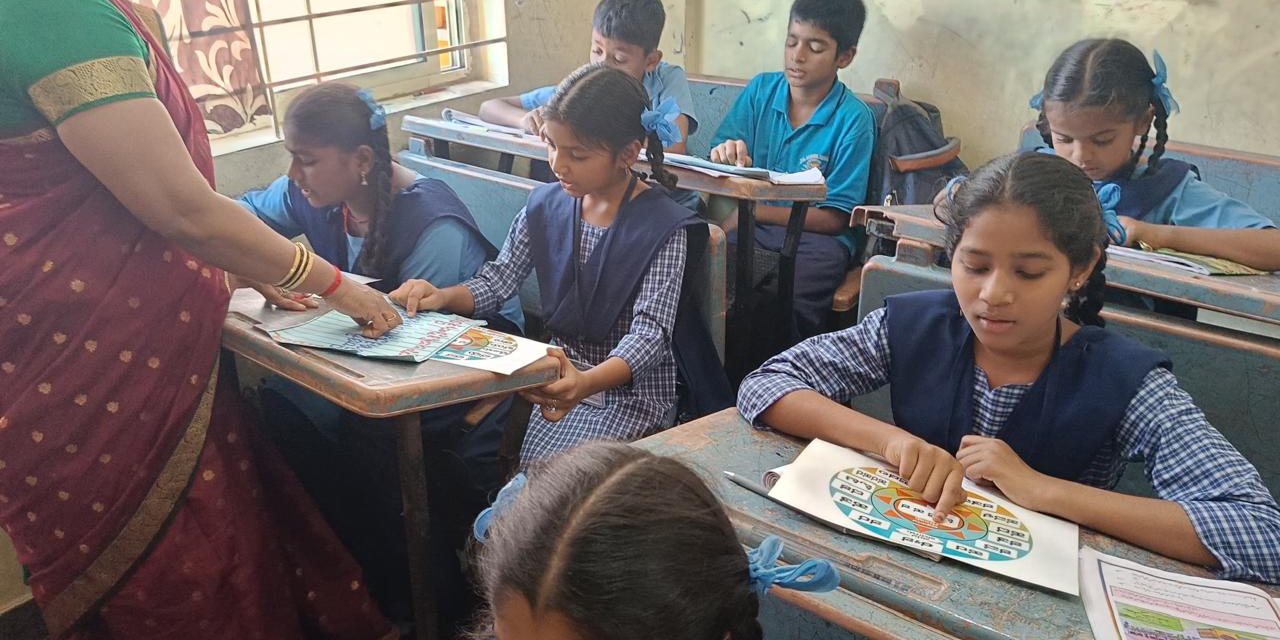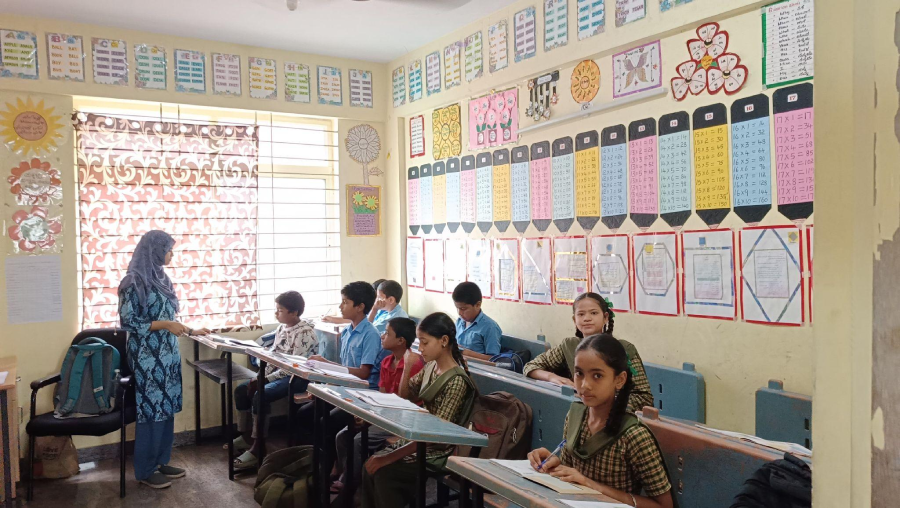It’s mid-day mealtime at the government school in Jigani. All 80 students gather in a 30 by 40 classroom where the meals are served- this hall also serves as a library, gathering area for morning assembly, parents meeting and other school events. In addition to this classroom, the school consists of a small office and two smaller classrooms. The school building occupies the entire site, with no room for any open space, playground or additional construction to suit the school’s needs. Student safety and wellbeing is a critical concern for the headmaster, as the school is flanked by a main road, and surrounded by a bustling market and high-rise buildings that block natural light and ventilation. The windows of the rooms remain mostly shut to block out noise, and the two teachers stay busy all day to engage students of different grades seated in the same classroom due to the shortage of space. The headmaster shares that the school stands on borrowed land from the community, and dedicated land is yet to be provided by the Panchayat.
This is the reality of the several school buildings in India. Data from UDISE+ 2023-24 reveals that nearly 18% of schools lack a playground, and 10% lack a library facility. Nearly 2000 schools still lack basic infrastructure such as drinking water and toilets for both genders. What’s more, as in the case of the school in Jigani, school sites in dense urban areas often lack the adequate space and external environment required to create a conducive learning environment. Children in such schools spend critical formative areas with little to no opportunity for psycho-motor stimulation or play in classrooms with poor daylight and ventilation and are distracted by noise and activity outside the classroom.
The National Curriculum Framework for School Education (NCF-SE) 2023 provides a holistic vision for the school’s physical environment. It states that,
‘Since most students spend close to six hours (or more) a day in school where they are engaged in a variety of activities, it is important to design school infrastructure in a way that addresses learning requirements and allows for play, gatherings, and interaction with others and with nature.’ (p. 537, NCERT, 2023)
Similarly, the Building as Learning Aid program envisions that school architecture must include opportunities for literacy development, stimulation for psycho-motor growth and be conducive to teaching and learning processes (BaLA, UN, n.d.).
In order to achieve such visions, educational sites must be carefully considered and prioritised in land use planning; policies need to speak with each other to address real challenges and set feasible goals. Often educational policies discount the concrete conditions where schools are located, and land use planning rarely prioritises planned allocation of sites for educational institutions. It is in this complex scenario that a story of change emerges from GUHPS Rajendra Nagara, Bangalore.
From Policy to Practice: Collaborative Leadership in Action
The GUHPS Rajendra Nagara School, located in the urban area of Bangalore South 3, conducts all activities in a single hall generously donated by the community. Additionally, the hall lacked proper flooring for students to comfortably sit and engage in classes, hampering their attention and interest in learning. All students and teachers share the same hall throughout the school day, making distractions a common affair. There were no toilets for students, requiring them to go home during breaks. Students’ overall participation was affected by these infrastructural limitations, as shared by Rabia of Grade 6:
“Our old school had only one classroom, and we all studied in the same room. There was no toilet in the school, so I had to go home to use the toilet. It will get too late to come back to school. It may cause missing class activities.”
The NCF-SE emphasises the role of the local community, including parents and Panchayati Raj institutions, in enabling sound infrastructure and resources for a conducive environment for teaching-learning. As any policy or framework must be executed in a localized manner, the Headteacher, Zarina Bi, who joined the school on promotion in 2022, decided to leverage the local community to create a happy and safe space for her students.
The leader’s motivated attitude, along with her advocacy and belief in the local leaders such as SDMC, played a crucial role in enhancing the learning environment of the school. By partnering with the Madrasas, the HM was able to secure a place for a new building, as well as secure any educational materials required for the school. The HM also focussed on building bridges with the community and developing a strong support network. Thus, the SDMC helped in fundraising involving the local community and alumni, which was directed towards construction. Community members were encouraged to volunteer their time and skills for construction work, maintenance or other school activities to support the school staff.
Through discussions in staff meetings anchored by the HM, a detailed proposal with the school’s needs was submitted to the MLA and followed up by the Cluster Resource Persons and SDMC, leading to the sanction of government funds for the construction of well-equipped, dedicated classrooms. Toilets were built for students and teachers to reduce interruptions during the school day. This improved the comfort and safety of both students and teachers and led to improved focus among students.
The HM conducts regular follow-ups to ensure that the facilities are maintained and any issues are promptly addressed. She also seeks feedback from students, teachers, and parents to continually improve the school environment.
The Result: Inspiring Spaces, Empowered Students
Over 2 years, the school, which started in a single hall, now has dedicated classrooms adorned with educational charts, posters, and student work to create an inspiring learning environment. The school walls have become visually stimulating environments that support literacy and learning. Students are constantly exposed to educational content, reinforcing their learning throughout the day.
The school is a part of the Vidyadeepa Program by Bangalore DIET, in partnership with Mantra4Change. The artefacts of the activities conducted by students as part of the morning assembly have also found their way to the school walls, enabling them to take pride in their work. Such contribution to the content displayed on school walls boosts their confidence and motivation.
Lessons in Leadership: Building a Culture of Collaboration
- Leading with Vision: The headmaster recognised the critical gaps in infrastructure and its effects and envisioned basic facilities and vibrant classrooms through collective action. This vision guided all efforts to transform the school, from mobilising resources to improving facilities.
- Engaging Local and Larger Community: By partnering with the parents, SDMC, Madrasas, and political representatives, the headmaster secured land for a new building, raised funds, and involved volunteers in construction and maintenance, fostering a sense of ownership and participation.
- Step-by-step Approach: The transformation began with small, actionable steps: submitting detailed proposals for government funding, securing temporary spaces, and focusing on immediate infrastructure needs like toilets and classrooms.
- Foster continuous improvement: Regular feedback from students, parents, and teachers ensured the facilities remained well-maintained and responsive to the community’s needs. This ongoing process created a culture of accountability and growth.
The transformation of GUHPS Rajendra Nagara stands as a testament to the power of collaborative leadership. Through the Headteacher’s proactive engagement with local stakeholders, including the SDMC, Madrasas, and community members, the school reimagined its learning environment to prioritise safety, comfort, and creativity. This approach underscores the importance of building partnerships that leverage local resources and collective will to address critical gaps in education infrastructure. By fostering a culture of shared responsibility and community participation, the school has not only enhanced its physical space but also empowered its students and staff to thrive in a supportive environment.
Captured and Authored by
Ravi, STEP-Bengaluru and Deepa, R&D






